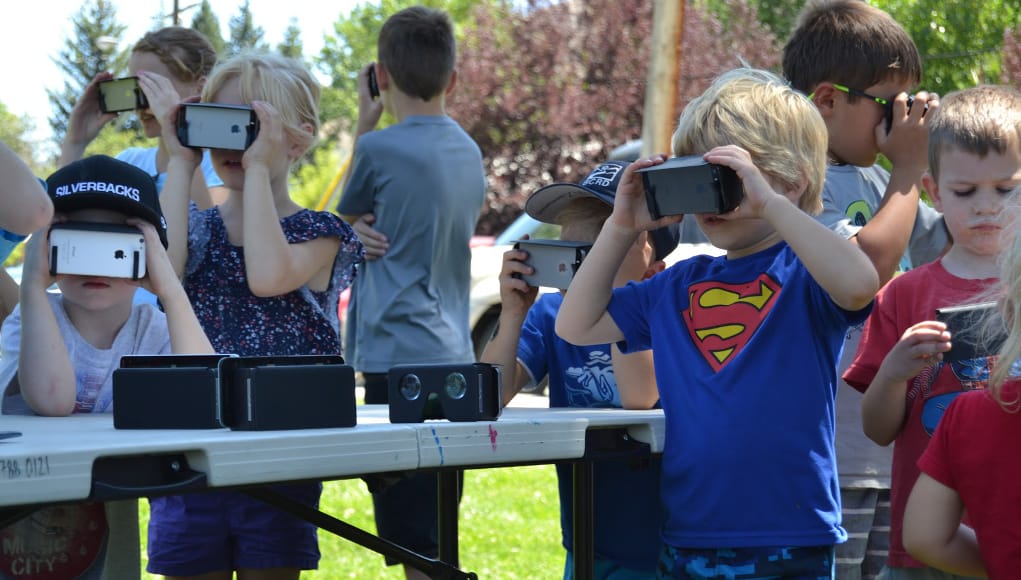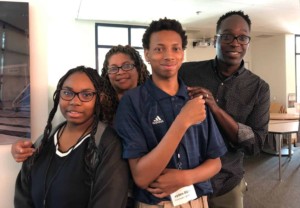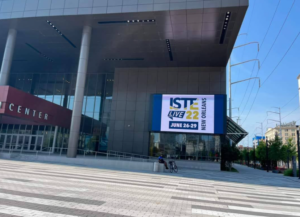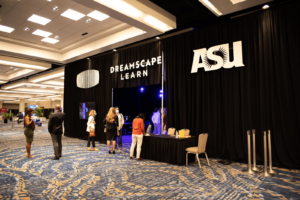Virtual Reality in the Park

By Paul Zimmerman
During the summer months, most kids are looking forward to playing outside on sunny days and taking vacations with family. In Wood River Valley, Idaho, kids now also look forward to Virtual Reality In The Park.
Every summer, a group of organizations comes together to offer new experiences to different communities in the area. The Hunger Coalition, which works to end hunger in the community by promoting solutions to the underlying causes of hunger, and its Bloom Truck team bring a generator powered trailer to different parks with free sack lunches for anyone who finds their way to the local park.
The Community Library, a privately funded public library, and its team bring a computer and a selection of books for kids to check out until the next time they arrive. And partnering with them all this year was the Blaine County School District team–we brought the virtual reality (VR).
 VR In The Park
VR In The Park
VR In The Park began in May when The Community Library reached out to create a partnership with Blaine County School District to bring our virtual reality program outside the classroom. Many of the library staff have students in the district, so they were familiar with our use of Google Expeditions (a virtual reality teaching tool that lets you lead or join immersive virtual trips all over the world). They’d heard their kids’ excitement as they described being inside animal cells and climbing Mount Everest during an otherwise normal school day, and wanted to provide this opportunity to more students in the community.
 I know virtual reality exploration is an excellent tool for building student engagement during the school year, so there was no reason to miss out on this summer volunteer opportunity. I signed up for each location the Bloom Truck was visiting across the entire summer, which amounted to five locations around the valley.
I know virtual reality exploration is an excellent tool for building student engagement during the school year, so there was no reason to miss out on this summer volunteer opportunity. I signed up for each location the Bloom Truck was visiting across the entire summer, which amounted to five locations around the valley.
Our virtual reality kit has seen great success as a learning tool in classrooms around the district. However, I discovered the real magic happens when you have a group of kids enjoying lazy summer days and a free lunch and then offer them a chance to visit the San Diego Zoo or to walk on the moon. Being able to bring the learning to them outside the classroom is the start of the most important lesson a child can learn: how to be a lifelong learner.
 The kit can accommodate up to 30 people at a time, which is perfect because we had parents just as engaged as students at each stop as well. Many of the kids did not know one another, but once they stood at the top of the Washington Monument together, they all became friends. It’s accurate to assume that each of them will have a chance to learn about the Washington Monument in school at some point, but I am willing to bet that the kids who saw it this summer via virtual reality in the park with strangers will remember why the marble changes color in the middle, versus those who read about it in a textbook.
The kit can accommodate up to 30 people at a time, which is perfect because we had parents just as engaged as students at each stop as well. Many of the kids did not know one another, but once they stood at the top of the Washington Monument together, they all became friends. It’s accurate to assume that each of them will have a chance to learn about the Washington Monument in school at some point, but I am willing to bet that the kids who saw it this summer via virtual reality in the park with strangers will remember why the marble changes color in the middle, versus those who read about it in a textbook.
Growing Virtual Reality In Our District
This is all not to say that virtual reality, in the classroom or the park, is a replacement for textbooks, online curriculum or teacher methods. In fact, virtual reality is simply a tool to enhance all of those.
A tool like this has the opportunity to bring to life things that otherwise would only live on a page or inside a screen, and experiences like these that have the ability to remove the barriers to education and the restrictions on discovery. Virtual reality makes learning real and engaging, regardless of location and that’s really what learning should be–engaging at any moment in any place.
VR’s impact on learning in our district continues to surprise me. When this project first began, staff were simply using the Google Expeditions app as a part of their lessons–but then it evolved into something more. Teachers started using the hardware for other tasks in their classroom, and students started to approach us wanting to create content in VR for various assignments.
In the span of a school year, our VR kit went from a tool to consume media to a tool integrated into classroom instruction to a content creation platform. We now have students and teachers exploring how to use 360 degree cameras in conjunction with current hardware to create live video feeds in VR.
This in itself is an exciting evolution, but looking at the big picture reveals one more thing virtual reality has accomplished. It has proven that an innovative tool, if properly integrated, does not need to be feared. Innovation in education means taking the “Wow” of a consumer product and finding a way for it to make sense in the classroom.
We don’t know exactly what types of jobs our students will have in the future, but it’s a good bet that understanding virtual reality will be a part of their needed skill set, as it can power everything from medical procedures to outer space exploration. Because of how we have integrated it into everyday curriculum, there will be no “Wow” factor for our students around working with VR–they’ll be able to get right to work.
 Virtual Reality Challenges
Virtual Reality Challenges
When thinking about the challenges of VR there can be many obstacles, but none are really insurmountable. For example, cost is the most important consideration for a school district and it’s a challenge we had to overcome from the start. The viewers we use cost around $30 each, considerably more than others, but we chose these for their durability, ability to be cleaned and their design (meaning the clips that hold the device are on the outside versus the inside so any phone will fit).
This leads to the next step in our approach–the phones needed for the app. We are sourcing ours from the community. That’s right, any recycled phones within the last few years will power an Expeditions kit. This means we can reduce our carbon footprint and save money. Reach out to parents, community partners or local businesses and you’d be surprised how many old phones are available.
In regards to student or classroom issues, luckily Google Expeditions does not require a student to move in any direction physically. They can stand in one place and look in all directions and be fully immersed in the experience.
The only real challenge we have seen that we’re not sure how to solve is that there simply isn’t enough time to explore all the places the kids request!
Next Steps To Create A VR Program
For anyone looking to grow their own classroom or district VR program, here are my recommended next steps:
- Start out with Google Expeditions, which will help everyone involved better understand educational VR versus consumer VR. When VR is seen as a tool for learning and not a novelty it’s much easier to integrate it into lessons.
- Look through these Google Slides to get a sense of a scalable approach. Often, people assume you need to start with a full set of 30 viewers for it to make sense and this simply isn’t the case. Starting small and growing it over time is just as effective as starting with 30. The engagement is the same–only the way it is applied is different.
- Once established, find opportunities to take your VR program out into your community to encourage lifelong learning and help students (as well as their parents) understand what VR in education really is.
One of our main goals as educators is to create a love of lifelong learning in our students, and virtual reality is definitely one way to do so. Immersing students in an experience can provide them with opportunities to see things they might not have seen in person, unlocking a need to expand their boundaries and explore our world.
- 7 Top Educational Virtual Reality Apps
- Learning With Virtual Reality Ignites Creativity and Career Exploration
- Design Interactive Place-Based Learning with Virtual Reality
Paul Zimmerman is a Technology Innovator in the Blaine County School District. Follow him on Twitter: @paulkzimm
Stay in-the-know with all things EdTech and innovations in learning by signing up to receive the weekly Smart Update.





0 Comments
Leave a Comment
Your email address will not be published. All fields are required.